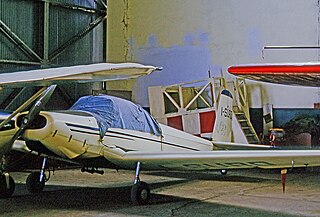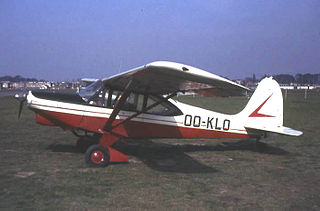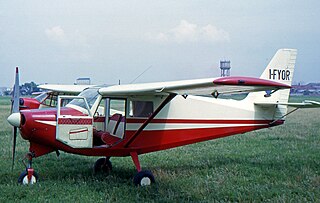
The Piper PA-23, named Apache and later Aztec, is an American four- to six-seat twin-engined light aircraft aimed at the general aviation market. The United States Navy and military forces in other countries also used it in small numbers. Originally designed as the Twin Stinson in the 1950s by the Stinson Aircraft Company, Piper Aircraft manufactured the Apache and a more powerful version, the Aztec, in the United States from the 1950s to the 1980s.

The Piper PA-24 Comanche is an American single-engine, low-wing, all-metal monoplane of semimonocoque construction with tricycle retractable landing gear and four or six seats. The Comanche was designed and built by Piper Aircraft and first flew on May 24, 1956. Together with the PA-30 and PA-39 Twin Comanches, it made up the core of Piper's lineup until 1972, when the production lines for both aircraft were destroyed in the 1972 Lock Haven flood.

The Aero Boero AB-95 is a small Argentine civil utility aircraft that first flew on March 12, 1959. It was built by Aero Boero S.A. of Córdoba. The AB-95 is a conventional high-wing monoplane built of fabric-covered metal structure. It has fixed undercarriage.

The Partenavia P.68, now Vulcanair P68, is a light aircraft designed by Luigi Pascale and initially built by Italian company Partenavia. It made its first flight on 25 May 1970, its type certification was granted on 17 November 1971 and was transferred to Vulcanair in 1998. The original six-seat high-wing monoplane is powered by twin piston engines and is used for light transport and training. The P.68 Observer is an observation aircraft variant, and it was developed in a stretched, 10/11-seat twin turboprop derivative.

The Aviamilano P.19 Scricciolo was a light civil trainer aircraft built in Italy in the 1960s.

The Boisavia B.60 Mercurey was a series of four-seat light aircraft developed in France shortly after World War II.

The Oberlerchner JOB 15 was an Austrian two-seat light aircraft produced by Josef Oberlerchner Holzindustrie, which had previously designed and built gliders.

The DINFIA IA 45 Querandi was a 1950s Argentine twin-engined light transport aircraft built by the DINFIA.

The Thurston Teal is a family of two- and four-seat all-aluminium amphibious aircraft designed by David Thurston in the United States and first flown in 1968.

The IAR-827 was an agricultural aircraft built in Romania in the 1970s and 1980s. The penultimate member of the family of designs that began with the IAR-821, it was, like the others, a conventional low-wing monoplane with fixed, tailwheel undercarriage, and shared the all-metal construction of the IAR-826. The prototype flew in 1976, powered by a Lycoming IO-720 engine, but the production examples that followed all had the PZL-3S.
The Partenavia P.55 Tornado was a 1950s Italian high-performance competition and touring monoplane built by Partenavia. The Tornado was a small mid-wing cantilever monoplane with a retractable tricycle landing gear. The aircraft was powered by a nose-mounted Lycoming O-320 piston engine.

The Malmö MFI-10 Vipan was a four-seat light utility monoplane designed and built in Sweden by Malmö Flygindustri. Only three aircraft were built and the type did not enter quantity production.

The Partenavia P.57 Fachiro is an Italian, four-seat, high-wing, touring monoplane, fitted with a fixed tricycle undercarriage.

The Wassmer WA-40 Super 4 Sancy is a French single-engined light aircraft of the 1960s and 70s. A single-engined low-winged monoplane with retractable nosewheel undercarriage, variants include the more powerful WA 4/21 Prestige and the WA-41 Baladou with a fixed undercarriage.
The Lambert Mission 212 is a conventionally laid out low-wing, fixed undercarriage, single-engine, four-seat kit built aircraft designed in the UK by a Belgian college student. Kits are manufactured in Belgium.

The Mylius My-103 Mistral is a German two-seat aerobatic trainer of utility aircraft produced by Mylius Flugzeugwerk of Bitburg.

The SGP M-222 Flamingo was an Austrian twin engine, four seat light aircraft, developed with a series of prototypes into the early 1960s. There was no series production.
The Peña Capeña is a French aerobatic amateur-built aircraft that was designed by competitive aerobatic pilot Louis Peña of Dax, Landes and made available in the form of plans for amateur construction.

The Bede BD-12 was an American homebuilt aircraft designed by Jim Bede and produced by Bede Aircraft of Medina, Ohio, introduced in the 1990s. The aircraft was intended to be supplied as a kit for amateur construction, but only one was ever built. It first flew in 1995.

The Vulcanair V1.0 is an Italian light aircraft, designed and produced by Vulcanair of Casoria, introduced at the AERO Friedrichshafen show in 2014. The aircraft is type certified by the European Aviation Safety Agency and the US Federal Aviation Administration and is supplied complete and ready-to-fly.


















